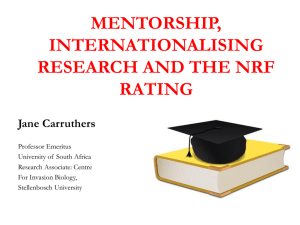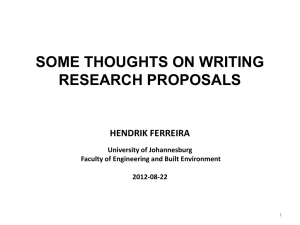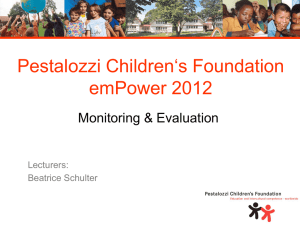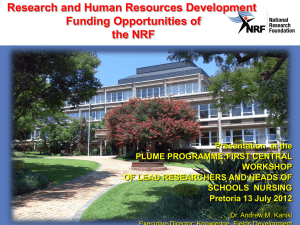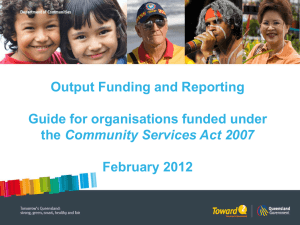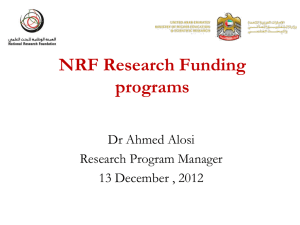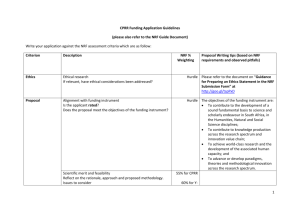NRF Evaluation & Rating - North
advertisement
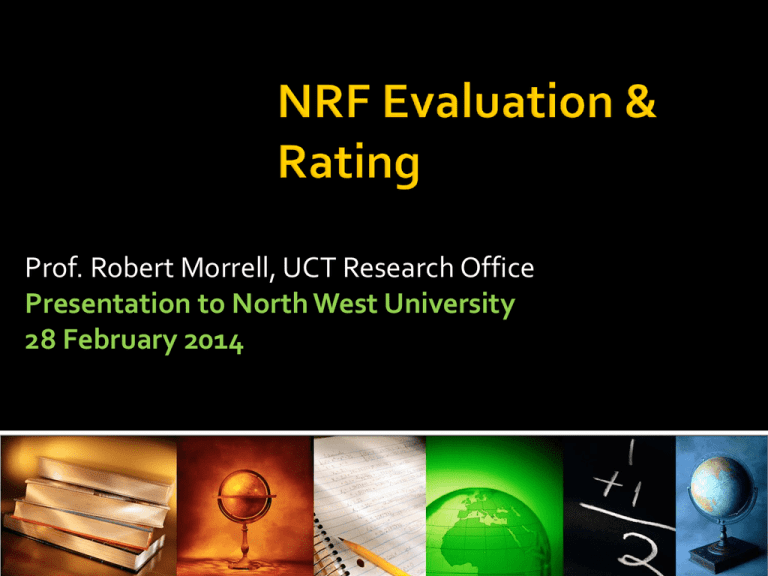
Prof. Robert Morrell, UCT Research Office Presentation to North West University 28 February 2014 What is an NRF rating? • Assessment of your recent research track record. • Based on the quality of your research outputs. • International peer-review system. Why be rated? • Access to NRF funding for 6 years. • Benchmarking. Assist NWU to improve its research profile. • Maintain publishing record. NRF rating categories Y, P Researchers who show promise to become established. C, B, A Established researchers. NRF rating categories: Definitions A B Researchers who are unequivocally recognised by their peers as leading international scholars in their field for the high quality and impact of their recent research outputs. Researchers who enjoy considerable international recognition … for the high quality and impact of their recent NRF rating categories: Definitions C Established researchers with a sustained recent record of productivity in the field. NRF rating categories: Definitions P Young researchers (normally younger than 35 years of age; doctorate or equivalent less than five years) who…are considered likely to become future leaders in their field. NRF rating categories: Definitions Y Young researchers (40 years or younger; doctorate or equivalent less than five years) who are recognised as having the potential to establish themselves as researchers within a five-year period after evaluation. RU Rating unsuccessful (a dreaded outcome!). If you are not successful with your rating application, you will receive this verdict and will have to wait for THREE years before you can apply again. Timing your Rating application • For a Y/P rating eligibility to apply is not altogether clear. Postdoctoral fellows were NOT eligible this year but might be in the next cycle. • There is no absolute number of research outputs that will determine when you are ready to apply and you need to make a calculation of quality vs quantity in answering the Question: Does my research work indicate that I have the potential to be an established researcher? Timing your rating application (2) • To apply for a ‘senior’ NRF rating (C,B,A) you need to ask yourself whether you’re established or internationally recognised or an international leader. • You can answer this by looking at your research outputs in the last 8 years. Have you published in high-impact, international journals? Have you led research projects and raised research funding as a PI? Have you been invited to international conferences, given plenary or keynote addresses? Has your research work had impact (what are your bibliometrics)? Planning for Rating • • • • Do you have a research and publishing strategy? What and where are you publishing? Are you developing a coherent research niche? Do you have research partners and international collaborators? • What are you doing to develop a research profile? Research Strategy • Balance between conference presentations, local journal articles, international journal articles, review articles, book chapters, edited books, monographs. • Research output and the creative arts? Engineering? ICT? Policy research? • Impact Factors and citations. How is your application processed? Submission of scholarly achievements Specialist Committee Not accepted Selection of 6 peers/reviewers Reviewers’ reports Assessor Specialist Committee Joint meeting How is your application processed? [2] Joint meeting Consensus B, C, Y Inform Applicant No Consensus A, P recommendation Executive Evaluation Committee Appeal Appeals Committee Peers/reviewers • Applicants are given the opportunity to nominate their own reviewers. • They are also given the opportunity to indicate who should not be approached. • A mix of national and international reviewers is appropriate in most cases. • Ideological differences within disciplines in the social sciences and humanities could confound the selection of suitable peers. However, reports by peers in such instances should be identifiable and treated appropriately by wise panel members. What do reviewers comment on? • Quality of research outputs over the review period (last eight years). • Impact of research outputs on the field. • Standing as a researcher, nationally and internationally. • Coherence of researcher’s work. Information required by NRF • Personal details • Biographical sketch (1 page) • Career profile • Description of completed research (2 pages) • Self-assessment (1 page) • Qualifications obtained • Research expertise • Ongoing and planned future research (1 page) • • Six nominated reviewers Research outputs of last eight years (2006-2013) • Five best recent research outputs (in the review period) • Ten best research outputs prior to review period • Assessment panel(s) • Publications in peer-reviewed journals • Technical reports • Books/chapters in books • Patents, artefacts and products • Peer-reviewed published conference proceedings • Keynote/Plenary addresses • Other significant conference outputs • Other recognised research outputs • Best outputs from students supervised in last 8 years Emphasis on peer-review and accessibility of outputs to reviewers Definition of research • For purposes of the NRF, research is original investigation undertaken to gain knowledge and/or enhance understanding. • • Research specifically includes: • the creation and development of the intellectual infrastructure of subjects and disciplines (e.g. through dictionaries, scholarly editions, catalogues and contributions to major research databases); • the invention or generation of ideas, images, performances and artefacts where these manifestly embody new or substantially developed insights; • building on existing knowledge to produce new or substantially improved materials, devices, products, policies or processes. • It specifically excludes: • routine testing and analysis of materials, components, instruments and processes, as distinct from the development of new analytical techniques. • the development of teaching materials and teaching practices that do not embody substantial original enquiry.
